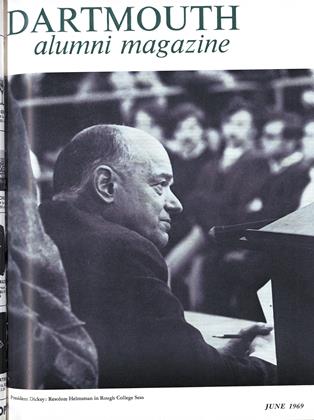Only an offbeat clairvoyant would have predicted that STANTON A. WATERMAN '46, cross-country runner in college and aerial high-flyer during three years with the Naval Air Corps, would be honored in 1967 as "Underwater Photographer of the Year."
However, one might have found an inkling of his future profession in the fact that at age fifteen, Stan had made his first dives off Palm Beach, Florida, using flipper fins hand-made from old rubber tires, and with a face mask imported from Japan, long before this item had ever been heard of in this country.
His professional scuba-diving career began in the Bahama Islands in the mid-fifties. It was out of Nassau that he filmed material for his first underwater movie entitled Water World. In subsequent winter seasons he showed his spectacular results on lecture tours throughout the eastern United States.
Waterman's next exploration took him to the Aegean Sea to find the wreck of a Greek merchantman that had sunk on a coastal reef off Turkey thirty centuries ago But first, near the port of Bodrum, he discovered parts of a ship which had been laden with amphorae, those classic jars used mainly for the storage of wine. At the surface these had been reduced to potsherds, but at a depth of 60 feet where they had been undisturbed by the tides and currents since the first century A.D., they lay in rows on the bottom.
But these discoveries were not Stan's prime quarry, and again he moved his operations southeastward by about 150 miles to Finike. There, in 90 feet of water, was the skeleton of the cargo ship he was looking for. Sunk in 1500 B.C., it had come to rest on a rock ledge at the base of a subterranean cliff. It had been enroute from the rich mines of Cyprus, the island which was the sole source of copper in the Bronze Age. Quantities of pure copper ingots weighing 60 pounds each were brought up, as well as sheets of pure tin. This whole journey formed the background of Waterman's next color presentation, 3000Years Under the Sea. And this was his lecture subject for the next several seasons.
In 1963, with his wife and children, he visited the Hawaiian Islands and filmed Man Looks at the Sea. Off the Island of Maui he filmed the native divers searching for rare black coral, which had previously been thought to be found only in the Red Sea. Excerpts from this documentary won three top awards in the United Kingdom Underwater Film Festival.
His latest photographic adventure involved the South Sea Islands. For a year Waterman lived in simple native style amid the breath-taking beauty of the Society Islands of Tahiti, Bora-Bora, and Raiatea. The result was Polynesian Adventure, which shows the life and ecology of the lagoons and deep reefs, and the relationship of the sea to the Polynesian existence. On this expedition, the entire Waterman family went along from their Princeton, N. J., home. Stan's wife Susanna, George, 17, Susanna, 16, and Gar, 13, had a year-long education in Polynesian life and in what Stan's work is like.
All four of Waterman's film productions have been shown on the CBS television network, with the National Geographic Society as sponsor.
Undoubtedly, there will be more of these adventures in the years ahead. "But," says Waterman, "after a certain period of time I'm not going to keep junketing all over the world. Some day I'm not going to be able to dive. Then I'll write and direct, which will be a nice way to taper off. The sea is the big future of the planet. We're at the threshold. I want to be around when man starts living under water."
 View Full Issue
View Full Issue
More From This Issue
-
 Feature
FeatureEight Graduates of Dartmouth Who Were First College Presidents
June 1969 By John Hurd '21 -
 Feature
FeatureTwelve Hours and Their Aftermath: The Student Seizure of Parkhurst Hall
June 1969 By C.E.W. -
 Feature
FeatureThe Class Officers Weekend
June 1969 -
 Feature
FeatureFOUR PROFESSORS WHO ARE RETIRING
June 1969 -
 Feature
FeatureBicentennial Year Begins June 14
June 1969 -
 Article
ArticleAlumni Awards
June 1969
HAROLD BRAMAN '21
-
 Article
ArticleFor Whom the Bell Tolled
February 1962 By HAROLD BRAMAN '21 -
 Feature
FeatureHORNING: Invention of the Devil
DECEMBER 1963 By HAROLD BRAMAN '21 -
 Article
ArticleAle Man
JANUARY 1969 By HAROLD BRAMAN '21 -
 Article
ArticleLens Artist
FEBRUARY 1969 By HAROLD BRAMAN '21 -
 Article
ArticleNephrologist
NOVEMBER 1969 By HAROLD BRAMAN '21 -
 Feature
FeatureMovie Producer
DECEMBER 1969 By HAROLD BRAMAN '21
Article
-
 Article
ArticleOCCOM POND WILL BE KEPT CLEAR ALL WINTER
February, 1926 -
 Article
ArticleELEVEN HONORARY DEGREES AWARDED AT COMMENCEMENT
AUGUST, 1927 -
 Article
ArticleDartmouth at Radcliffe
December 1943 -
 Article
ArticleThayer School
January 1946 -
 Article
ArticleRetires as Naval Designer
February 1952 -
 Article
ArticleThe Undergraduate Chair
February 1974 By DREW NEWMAN ’74

